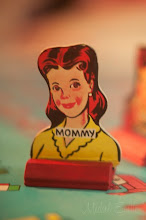A lot of people ask how to get the fuzzy background you see on blogs, pinterest, and other websites. The fuzz has a name. It is called "bokeh". Bokeh sets a photo apart from the norm and it helps isolate the subject and draw your eye to what the photographer wants you to see. How to achieve the bokeh comes from learning to control your depth of field. My posts on Aperture (here and here) explain the how, but you also need the right equipment.
Before I get into different lenses for SLR cameras, here is a cheat to get bokeh on a point and shoot camera. Set the camera to macro. That is the "flower" setting on your camera. And try zooming in on the subject, but not too much, because you don't want to add a lot of noise or graininess to your photo. Here is a Flickr discussion on the topic: "Is bokeh with point and shoot possible".
If you have invested in an SLR with a kit lens you might be a bit frustrated trying to achieve bokeh. Or if you bought a reasonably priced (i.e. it didn't cost over $1,000) zoom lens, you might be getting bokeh, but the image is soft without that crisp detail you see elsewhere.
To get this kind of detail and bokeh you need a fast lens. The lower the f(aperture) number the faster the lens. How do you know what the largest(lowest) aperture you lens can achieve? Look on the edge of the lens. Lets take a look at Canon's 18-55mm kit lens for example. On the edge you would find numbers like this: 18-55mm 1:3.5-5.6. First to explain the 18-55mm - this is the focal length which tells how wide a swath of the scene in front of you the resulting image will hold. Lower numbers like 20mm are very wide and great for landscapes and higher numbers like 85 are good for portraits - leaving out a lot of the background and distracting objects. You can find examples on the page I linked above. After that, it will have numbers that look like this 1:3.5-5.6. So this lens has an lowest aperture possible of f/3.5 (5.6 at 55mm). To get bokeh like the image above and stay sharp you need a fast lens that can go even lower than f/3.5.
Buying a lens with this ability can be very expensive. If it is a zoom lens (one that you can stand in one spot and zoom in and out) you will pay a lot more than if you buy a fixed lens. Over $1,000 easily. What is the difference in a zoom and a fixed lens. With a zoom lens if you are walking along and see something 'over there' you pick up your camera and zoom in using your lens to take the photo. With a fixed lens, if you see something 'over there' you need to walk over there to take the photo. It can't zoom in. What you see through the lens is it unless you move closer or further back. So for those, like me, who want to conserve their money, we have to resolve to doing a bit more legwork. It hasn't been a big issue for me. I own two fixed lenses. One is a 50mm 1.8 and an 85mm 1.8. I use both for portrait work. I have no kids in sports and I don't do landscapes, so these lenses work for what I take photos of: kids, cats, and stuff to sell on Etsy. Here's the good news - a 50mm 1.8 runs around $100!! So much better than spending over $1k.
So, if you are just starting out, I suggest purchasing a fixed lens that is fast and sharp and gives you great bokeh. It is cheap, great to learn on, and will give you beautiful images that you can be proud to display and submit to contests. A lot of people who do portraits purchase a 35mm or 50mm lens. The 85mm costs a bit more. And a tip, the longer the focal length the further away you need to be from your subject, so an 85mm isn't a good indoor lens. You can also go faster but you will pay more. Like a 50mm 1.4 is faster and costs closer to $400 instead of $100 like the 50mm 1.8. Flickr is a great place to find examples of images taken with different lenses.
Where to buy?
A very old, trusted name in photography is BH Photovideo, but you can also purchase lenses through places like Amazon or even Ebay. Also, KEH is a used camera shop, which has also been around for a long time and is also trusted. My Canon 1Ds was bought through them years ago. They are also a repair shop.


No comments:
Post a Comment